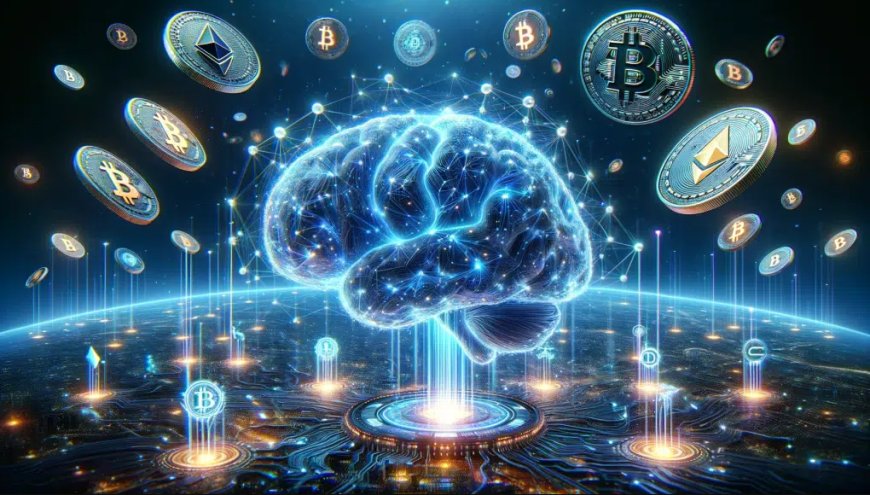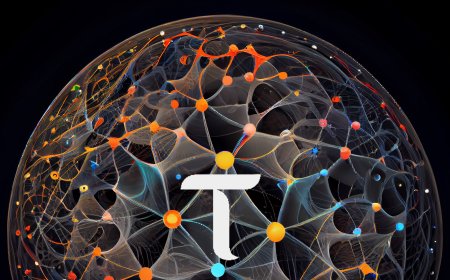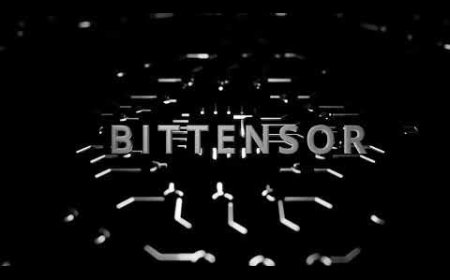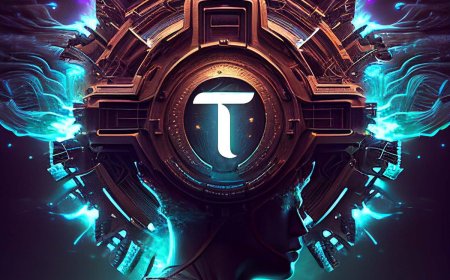Revolutionizing AI and Blockchain: Bittensor's Subnet 8 and the Request Network
The rapidly evolving world of artificial intelligence and blockchain technology has found a powerful intersection in Bittensor, a decentralized network that's pushing the boundaries of what's possible in both fields. In a recent discussion, Arash, the mastermind behind Subnet 8 (PTN) and the Request Network, shed light on the innovative developments within the Bittensor ecosystem. This article delves into the groundbreaking work being done on Subnet 8, the potential of the Request Network, and the future of decentralized AI and finance.

Subnet 8: A Decentralized Prop Trading Network
Subnet 8, also known as PTN (Proprietary Trading Network), represents a significant leap forward in the application of AI to financial markets. Arash explained the evolution of PTN from its initial focus on time series prediction to its current form as a decentralized prop trading platform:
"We realized the time to value was just going to take longer than we expected, and we needed to push for more value faster. So we forced miners to provide us valuable signals... Miners take their ML models that they've created and need to create and provide valuable signals from their strategies."
Key features of Subnet 8 include:
- Long/short signals across multiple asset classes: PTN allows miners to generate trading signals for a variety of markets, including crypto, forex, indices, and potentially metals and oils in the future.
- Rigorous performance metrics and risk management: The subnet implements strict criteria for miner performance, including daily and total drawdown limits, mirroring the risk management practices of traditional prop trading firms.
- A challenge phase for miners before receiving incentives: This ensures that only high-quality strategies are rewarded, maintaining the overall value of the network.
- Sophisticated plagiarism detection mechanisms: To maintain the integrity of the network, PTN has implemented systems to flag and potentially penalize miners who copy strategies from others.
The subnet has implemented a unique incentive structure that closely mirrors traditional proprietary trading firms. Miners (traders) must pass a challenge phase and maintain strict risk management criteria to receive rewards. This approach ensures high-quality signals and aligns incentives with real-world trading performance.
Arash highlighted the competitive nature of the platform: "It's highly competitive. I mean, you're trying to take your predictive model, and you're building a strategy around it. And so far, the results have been outstanding. The top miners are providing insane results, truly."
One of the most impressive aspects of PTN is its ability to generate consistent returns. Arash mentioned a particular miner called Tarvis, which has an incredible win rate: "Tarvis is only lost one time in the last pretty much since inception. It's 45 and one, I think, in trades."
The Request Network: Empowering Validators and Consumers
One of the most exciting developments discussed was the Request Network, a platform designed to bridge the gap between validators, subnet owners, and consumers. The Request Network aims to create a marketplace where validators can offer their services directly to consumers, fostering a more decentralized and efficient ecosystem.
Key features of the Request Network include:
- Peer-to-peer interactions between validators and consumers: This direct connection eliminates the need for intermediaries, reducing costs and increasing efficiency.
- Web3 payment integration for transparent transactions: By leveraging blockchain technology, the Request Network ensures all transactions are traceable and verifiable.
- Comprehensive analytics dashboard for validators and consumers: This feature provides valuable insights into service performance, revenue, and user engagement.
- Cross-subnet service integration: The Request Network allows for collaboration between different subnets, potentially leading to more complex and valuable AI services.
Arash explained the motivation behind the Request Network: "The idea behind the Request Network has always been, you know, these validators hold the data or the ability to extract the information. How do we enable the validators to further spread that information? How do we make them storefronts for consumers?"
The Request Network is designed to be open-source and community-driven, with a focus on decentralization and transparency. It allows validators to monetize their services without relying on centralized intermediaries, potentially opening up new revenue streams for participants in the Bittensor ecosystem.
One of the most innovative aspects of the Request Network is its ability to track and display network-wide metrics. Arash explained: "We're going to know throughput across all subnets. We're going to know traffic information, revenue information across all subnets that use the Request Network, and we're going to be able to display that to all the validators."
Incentive Mechanisms and Network Evolution
Throughout the discussion, Arash emphasized the importance of proper incentive alignment in subnet design. The evolution of Subnet 8 from a time series prediction model to a prop trading network demonstrates the need for flexibility and adaptability in the face of changing market dynamics.
"We learned so much in that period where we were trying to figure out the best ways and incentive mechanisms to get miners to provide us predictions in the way that we wanted," Arash reflected. "We realized the most important thing as a subnet owner is really time to value."
This focus on rapid value creation has led to innovative approaches in dealing with challenges such as plagiarism and signal copying. Rather than implementing strict prevention measures, Arash and his team are exploring ways to leverage these behaviors to strengthen the network:
"Maybe it makes better signals... When you're talking about hierarchical models, for instance, miners are using the outputs of multiple miners as inputs to themselves. What if you just let the miners do that themselves?"
This open-minded approach to potential challenges showcases the adaptability and forward-thinking nature of the Bittensor ecosystem. By embracing and potentially leveraging behaviors that might initially seem problematic, the network can evolve in unexpected and beneficial ways.

The Future of Decentralized AI and Finance
The conversation touched on several exciting prospects for the future of Bittensor and its subnets:
- Theta Signals: Using the aggregate output of PTN to create even more sophisticated trading models. Arash explained: "We can use the output of all these signals... to generate bigger features, like ultimate features for a better model."
- Marketplace of Signals (MOSS): A platform for data providers to offer valuable features to miners. This marketplace could include various data sources, from social media sentiment to technical indicators, allowing miners to enhance their models with diverse inputs.
- Cross-subnet collaboration: Leveraging the strengths of multiple subnets to create more powerful applications. The Request Network's ability to facilitate interactions between different subnets opens up new possibilities for complex, multi-layered AI services.
- Automated trading for the masses: Arash hinted at future developments, saying, "We're building a product to enable automated trading for anybody. You can just take the sophisticated strategy built off of PTN that's transformed and usable for yourself on any exchange."
The Request Network is poised to play a crucial role in this ecosystem, providing the infrastructure for validators to monetize their services and for consumers to access high-quality AI-driven products easily. This could potentially democratize access to sophisticated trading strategies and other AI-powered tools that were previously only available to large institutions or wealthy individuals.
Challenges and Considerations
While the potential of these developments is immense, several challenges were also discussed:
- Ensuring fairness and preventing exploitation in subnet design: As the network grows, maintaining a level playing field for all participants becomes increasingly important.
- Balancing openness and plagiarism prevention: While copying strategies can potentially improve overall network performance, it's crucial to maintain incentives for original research and development.
- Scaling infrastructure to meet growing demand: As more users and services join the network, ensuring smooth operations and low latency becomes a priority.
- Maintaining decentralization while providing user-friendly interfaces: Striking a balance between the decentralized ethos of blockchain and the need for accessible, user-friendly platforms is an ongoing challenge.
- Regulatory compliance: As the network deals with financial data and potentially facilitates trading, navigating the complex regulatory landscape will be crucial for long-term success.
Arash acknowledged these challenges and emphasized the importance of community feedback and iterative development: "We're monitoring, but we're at the same time trying to learn what exactly we are looking for."
This commitment to continuous improvement and adaptability is a key strength of the Bittensor ecosystem, allowing it to evolve in response to user needs and technological advancements.
The Role of Community in Bittensor's Development
One of the most striking aspects of the discussion was the emphasis on community involvement in the development and governance of the Bittensor ecosystem. Arash mentioned ongoing efforts to create a community-driven committee to oversee subnet weighting and other crucial decisions:
"We are working on an idea to better support validators in deciphering and distribution of weights to different subnets and to kind of find more alignment and provide more alignment across validators, creating this community-driven committee."
This focus on decentralized governance and community input sets Bittensor apart from many other blockchain projects. By empowering community members to have a say in the network's direction, Bittensor aims to create a truly decentralized and resilient ecosystem.
The Impact on Traditional Finance and AI Industries
The innovations being developed within the Bittensor ecosystem have the potential to disrupt both the traditional finance and AI industries. By providing a decentralized platform for sophisticated trading strategies and AI models, Bittensor could challenge established prop trading firms and hedge funds.
Moreover, the open and collaborative nature of the network could accelerate the pace of innovation in AI and machine learning. By allowing researchers and developers to build upon each other's work in a transparent and incentivized manner, Bittensor could become a hotbed of cutting-edge AI development.
Conclusion
The innovations being developed within the Bittensor ecosystem, particularly Subnet 8 and the Request Network, represent a significant step forward in the convergence of AI, blockchain, and decentralized finance. By creating robust incentive mechanisms, fostering community-driven development, and focusing on rapid value creation, Bittensor is paving the way for a new era of decentralized intelligence and financial services.
As these projects continue to evolve, they hold the potential to revolutionize how we think about trading, data marketplaces, and the monetization of AI services. The emphasis on transparency, peer-to-peer interactions, and community governance sets a new standard for decentralized platforms.
For developers, traders, and AI enthusiasts alike, the Bittensor ecosystem offers exciting opportunities to participate in cutting-edge technology at the intersection of AI and blockchain. The open nature of the network allows for rapid iteration and improvement, potentially leading to breakthroughs in AI and machine learning that might not be possible in more closed, traditional research environments.
As Arash and his team continue to refine and expand these platforms, we can expect to see even more groundbreaking developments in the near future. The success of projects like Subnet 8 and the Request Network will likely have far-reaching implications for the broader blockchain and AI industries, potentially reshaping how we approach everything from algorithmic trading to data marketplaces and beyond.
The future of Bittensor looks bright, with its unique blend of decentralized governance, innovative incentive structures, and cutting-edge technology positioning it at the forefront of the AI and blockchain revolution. As the ecosystem grows and matures, it will be fascinating to watch how these innovations impact the wider world of decentralized technology and finance, potentially ushering in a new era of open, collaborative, and highly sophisticated AI-driven services.
Source : @Opentensor Foundation
















